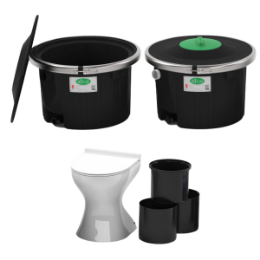Grey Water Technology
What is Greywater?
Greywater is the wastewater produced from the hand basin, shower, bath, washing machine, laundry tub, kitchen sink and dishwasher. Greywater from the kitchen sink or dishwasher is generally too high in grease and oil to be reused successfully and should be treated differently from all other greywater.
Note that greywater it is not the water from a flushing toilet as this is contaminated with human waste and is called blackwater.
Greywater for irrigation (RE-USE)
Greywater irrigation has long been practised in areas with a limited water supply. However, proper precautions for its use have not always been in place. This has posed a problem for health officials, who believe there is no correct method for managing greywater to both balance user water needs with public safety considerations. While the engineering of these systems is still a relatively new technology, it is one that is progressing rapidly. Greywater systems can now meet both environmental and waste management requirements, while safely utilising the nutrient content in the effluent.
The options for safely using greywater as a source for irrigation are many and diverse.
There are two types of greywater systems for the domestic market that both require local government approval and state government guidelines for installation:
- GWDD (Greywater Diversion Device) Diversion Systems are a primary filtration device that provides discharge to the land within a 24-hour period and are either gravity or pumped
- DGTS (Domestic Greywater Treatment Systems) - Treatment systems, upgrade water quality in the process and should provide a secondary treatment level, this will provide a more flexibility means of discharge and re-use irrigation applications. For light use
- CGTS (Commercial Greywater Treatment Systems) - Treatment systems, upgrade water quality in the process and should provide a secondary treatment level, this will provide a more flexibility means of discharge and re-use irrigation applications. For high use
N.B. All greywater diversion systems MUST use by law, a subsurface or substrata irrigation discharge system, such as drip irrigation.
N.B. If a greywater treatment system DGTS is being used rather than a Greywater Diversion Device GWDD, the waste water from the kitchen can be included.
Recommendation for Consideration
The ideal means of discharge for greywater is done by pressurized dripper lines, not gravity feed trenches Read About Dripper Systems Here
For all greywater sources when including kitchen wastewater a DGTS system must be used.
If irrigation with greywater (Re-Use) is desired when kitchen wastewater is involved, a dual system can be set up onsite where about 50% of the greywater is used via a GWDD & GWDD-irrigation system and the back-flush waste from the GWDD is diverted into a DGTS or CGTS and treated before discharge (Re-Use)onsite.
| A Scale of Greywater Types | Heavy Dark | Dark | Medium | Medium Light | Light |
| Types of Wastewater | Kitchen Wastewater | Laundry Wastewater | Bathing Wastewater | Hand Basin Wastewater | Overflow & Floor Drain Wastewater |
| Types of Treatment Systems | DGTS & CGTS | DGTS & CGTS & GWDD | DGTS & CGTS & GWDD | GWDD | GWDD |
*Greywater is often referred to in shades. 5 shades are known.
Passway™ | M-43D Tank Riser (150mm)
GreyFlow™ | GREYFLOW PRO - STAGE 1 OF 2: BUILDERS KIT (PART A)
Nature Loo™ | Alectura Comfort
Nature Loo™ | Alectura Premium

You will be able to take part in our Review rewards program!
Earn points for your product reviews!
Just review any product that you have purchased and receive your points!





























